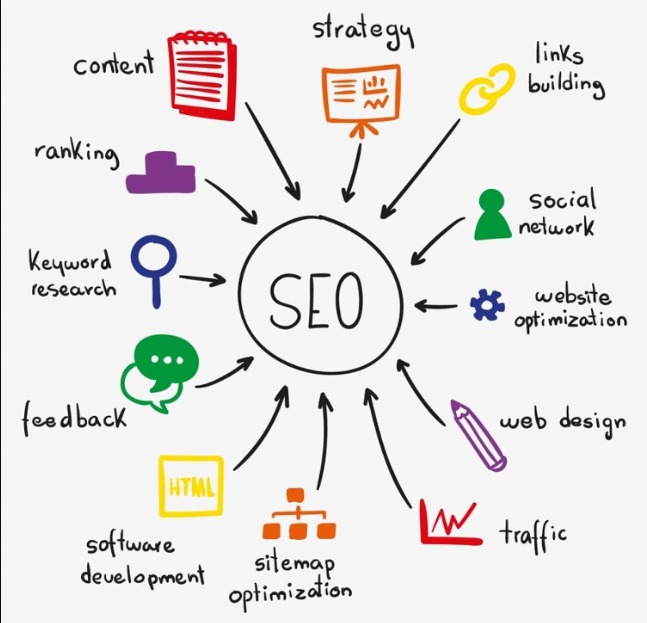In today’s competitive online world, ranking higher on search engines like Google is essential for any business, whether you’re a local teaching institute in Pakistan or an ecommerce store. SEO (Search Engine Optimization) is one of the most effective ways to boost your website’s visibility and organic traffic. But achieving high rankings isn’t always easy, especially with constantly changing algorithms and fierce competition.
However, by implementing some low-hanging SEO strategies, you can quickly improve your website’s ranking and see measurable results. In this blog, we’ll walk SEO strategies.
What is SEO?

SEO, or Search Engine Optimization, refers to the practice of optimizing a website to improve its rankings on search engine results pages (SERPs). The goal is to enhance your website’s visibility, making it easier for potential customers to find you when they search for relevant keywords or phrases. SEO includes a range of tactics, from on-page optimization like keyword usage to off-page techniques such as building backlinks.
Why is SEO Important?
SEO is important because it directly impacts the visibility and discoverability of your website. When your website ranks higher on search engines, you attract more organic traffic, which means more potential customers or clients. For ecommerce businesses, improved SEO can lead to more product views and sales.
SEO also builds trust and credibility. Users are more likely to trust websites that appear at the top of search results. Additionally, SEO is cost-effective compared to paid advertising, offering long-term benefits when implemented correctly.
5 Basic SEO Strategies
Here are five fundamental SEO strategies you should focus on to improve your ranking:
On-Page SEO Optimization – Optimize your website’s pages by ensuring that each page has relevant, high-quality content, proper keyword usage, meta tags, and a user-friendly structure.
Technical SEO – Make sure your website is technically sound with fast loading speeds, mobile optimization, a secure HTTPS connection, and a clear URL structure.
Link Building – Secure high-quality backlinks from reputable websites to increase your domain authority.
Content Marketing – Create valuable and informative content regularly to attract and engage your audience. High-quality content that answers users’ questions is crucial for ranking higher.
Local SEO – For local businesses, optimizing your website for local search is crucial. Use local keywords and set up a Google My Business profile to attract local customers.
Strategies to Boost Your Ranking
Now that you have a solid understanding of SEO basics, let’s dive into some advanced yet simple strategies that can quickly improve your rankings:
Strategy 1: Move Already Ranking Pages to a Better Position
If you have pages on your website that are already ranking but not in the top positions, there’s a lot of potential to boost them higher. Start by reviewing your Google Search Console to identify pages that are ranking between positions 5 and 10. These pages are already getting some traffic, so with a few adjustments, you can push them to the top.
You can improve these pages by updating their content, optimizing on-page elements like title tags and meta descriptions, and building internal links to them from other high-authority pages on your site. This can significantly increase their visibility and performance.
Strategy 2: There’s Always Scope for New Keywords
Effective SEO keyword research is key to finding new keywords that your competitors may be missing out on. No matter how competitive your niche is, there will always be low-competition, long-tail keywords you can target.
By conducting thorough SEO keyword research using tools like SEMrush, Ahrefs, or Google Keyword Planner, you can uncover new opportunities for ranking. Identify search terms that your target audience is using but that your competitors aren’t targeting effectively. Incorporating these keywords into your content will give you an edge over the competition.
Strategy 3: Content Gap/Keyword Gap from Competitors
One of the best ways to get ahead of the competition is by identifying content gaps—topics or keywords that your competitors are ranking for, but you aren’t. By finding these gaps and creating high-quality content around them, you can quickly fill the void and rank for those keywords.
This strategy requires competitive research. Use tools like SEMrush or Ahrefs to analyze the keywords your competitors rank for and identify the ones you are missing. Then, create content that targets those keywords and provides more value than what your competitors are offering.
Strategy 4: Refresh Your Outdated Content with Declining Rankings
Content doesn’t stay relevant forever, and outdated content with declining rankings can be a significant drag on your SEO performance. If you have old blog posts or pages on your website that are no longer performing well, it’s time to refresh them.
Updating content with new statistics, improved formatting, better keyword targeting, and additional information can bring old posts back to life. This not only improves your rankings but also keeps your audience engaged with up-to-date information.
Strategy 5: Check Cannibalization Keywords & Solve This Problem
Keyword cannibalization happens when multiple pages on your website target the same or very similar keywords. This confuses search engines and often results in your pages competing against each other, leading to lower rankings overall.
To fix this, you need to identify keyword cannibalization issues. Tools like Google Search Console, SEMrush, and Ahrefs can help you identify pages targeting the same keywords. Once identified, you can either merge the content of the competing pages or re-optimize them to target different, more specific keywords.
If you’re serious about mastering SEO, consider enrolling in the best SEO course available to improve your skills and stay updated on the latest SEO trends.


